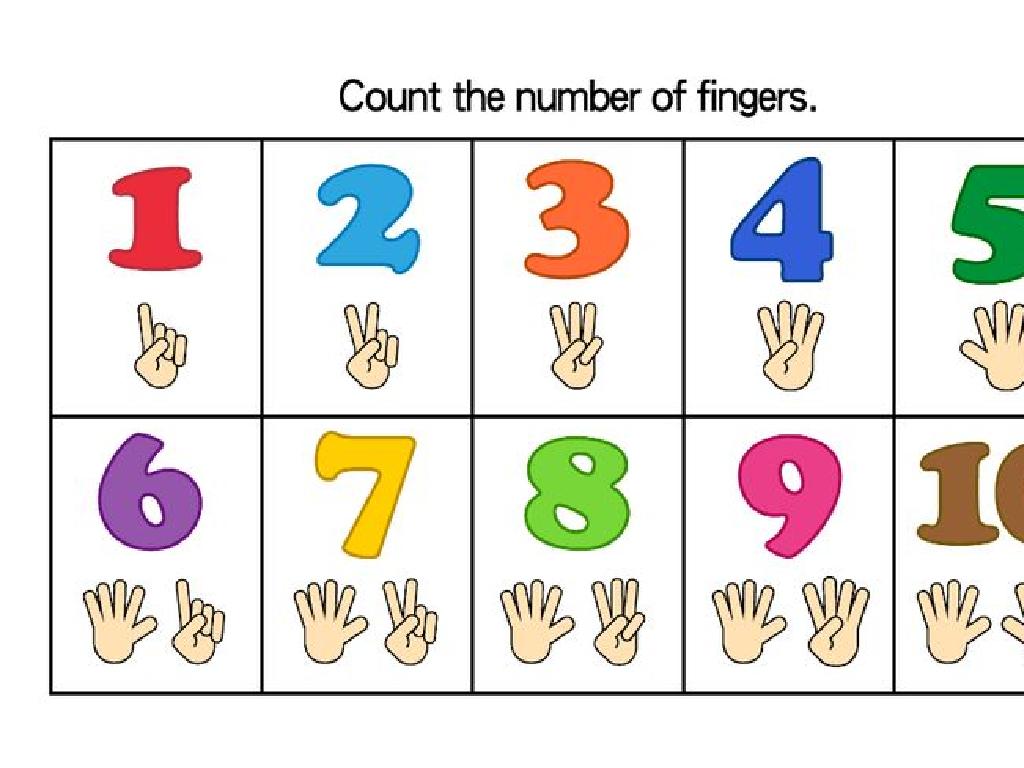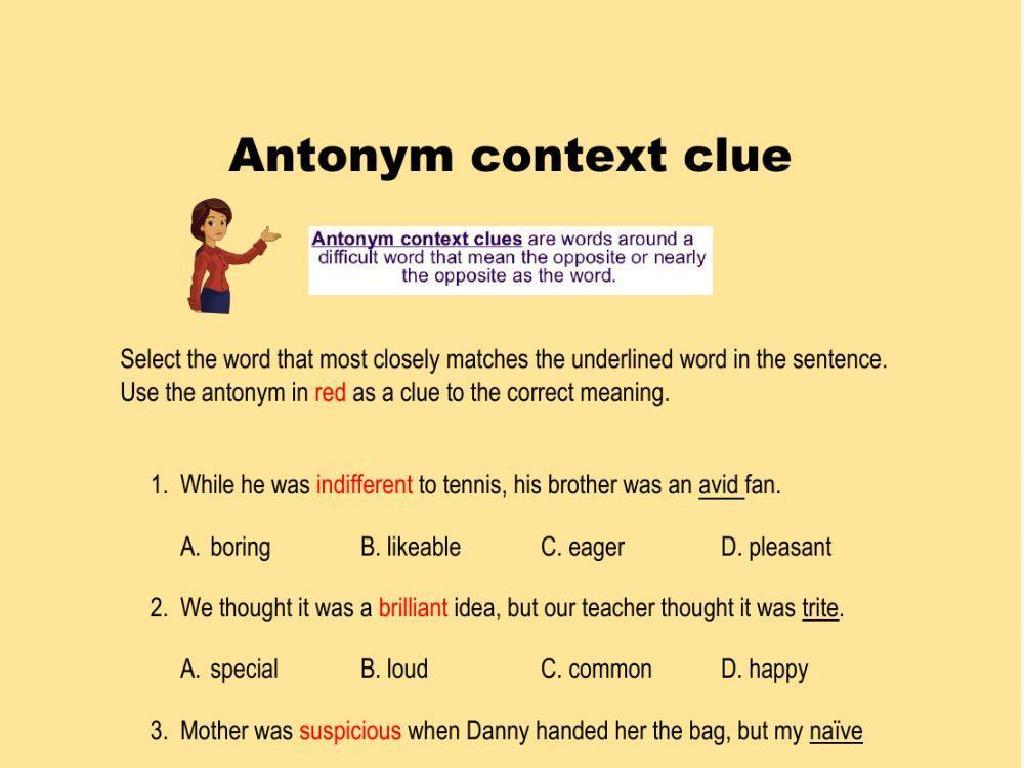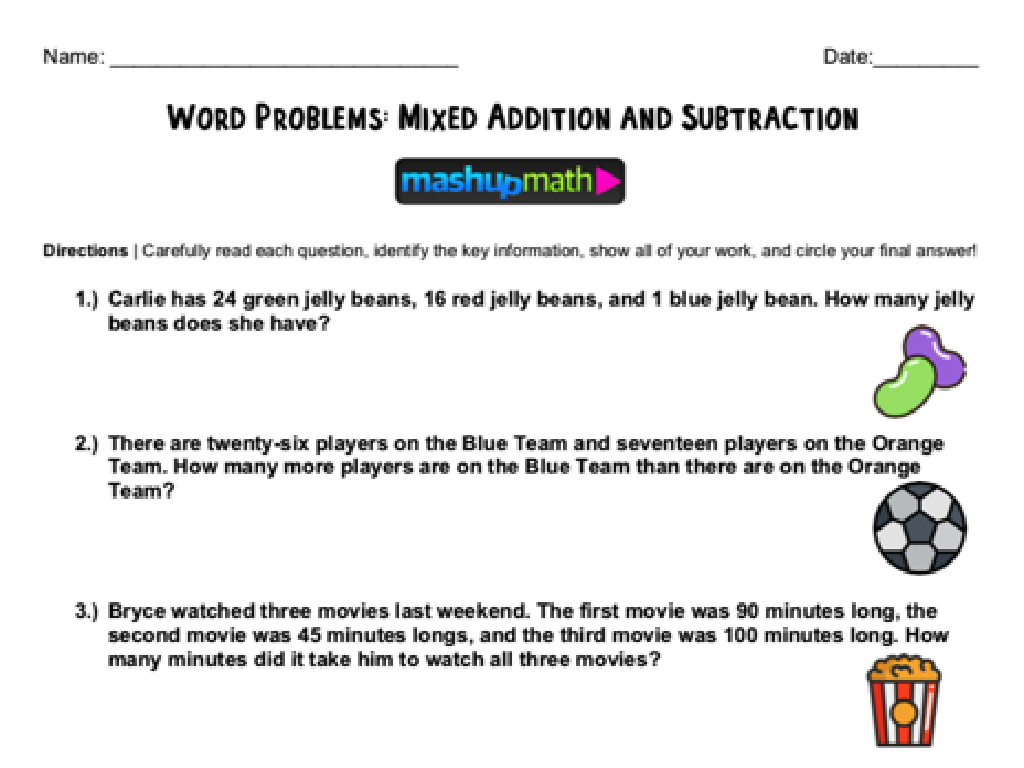Complete The Addition Sentence - Sums To 20
Subject: Math
Grade: Second grade
Topic: Addition: One Digit
Please LOG IN to download the presentation. Access is available to registered users only.
View More Content
Welcome to Addition: Sums to 20
– Becoming addition experts today
– Making numbers add to 20
– If we have 13, what plus 13 equals 20?
– Addition means putting together
– Like combining 2 sets of toys
– Practice with fun examples
– Example: 10 + ? = 20, so the missing number is 10
|
This slide introduces the concept of addition with sums up to 20, tailored for second graders. Start by engaging the students with the idea of becoming ‘addition experts’ by the end of the lesson. Explain that addition is the process of combining two or more numbers to get a new total. Use relatable examples, such as combining toys or pieces of candy, to illustrate the concept of addition. Provide simple examples and encourage students to participate by thinking of what number can be added to another number to make 20. For instance, if we have 10, what do we need to add to it to get 20? The answer is 10. This interactive approach will help students understand and enjoy the process of addition.
Understanding Addition: Sums to 20
– Addition combines numbers
– Think of it like adding more apples to a basket
– The plus sign (+) is key
– Adding makes numbers grow
– Like when you save more coins in your piggy bank!
– Practice sums up to 20
– Examples: 7 + 13 = 20, 11 + 9 = 20
|
This slide introduces the basic concept of addition to second graders. Start by explaining that addition is the process of combining two or more numbers to make a new, larger number. Show the plus sign and ensure students recognize it as the symbol for addition. Use relatable examples like adding more items to a collection to illustrate that the total count increases. Finally, engage the students with simple addition problems that sum up to 20, reinforcing the concept with hands-on practice. Encourage students to use their fingers, counters, or drawings to visualize the addition process.
Let’s Practice Addition: Sums to 20
– Understanding addition
– Example: 5 + 3 = 8
– Adding 5 and 3 gives us 8
– Visualize with real objects
– Imagine 5 apples and 3 oranges in a basket
– Find pairs that add to 20
– What numbers can we add to 5 to get 20?
|
This slide is aimed at helping second-grade students understand the concept of addition by visualizing and relating it to real-life objects. Start with the basic example provided, 5 + 3 = 8, and ask students to visualize objects they are familiar with, such as fruits, to make the concept more tangible. Encourage them to think of different pairs of numbers that can be added together to reach the sum of 20. This will help them grasp the idea of addition and how different combinations of numbers can result in the same sum. For the activity, students can use physical objects like counters or draw pictures to represent the numbers they are adding together. The goal is to make addition fun and relatable while reinforcing the concept that there are multiple ways to reach the same sum.
Adding to Make Sums of 20
– What is a ‘sum’ in addition?
– A ‘sum’ is the result of adding numbers together.
– Today’s goal: sums equal to 20
– We will find pairs of numbers that add up to 20.
– Using a number line for addition
– A number line can help us see the addition.
– Practice with examples
– Try 8 + __ = 20, what number goes in the blank?
|
This slide introduces the concept of sums in the context of addition, with a specific focus on finding sums that equal 20. Begin by explaining that a ‘sum’ is the total we get when we add two or more numbers. Today’s objective is for students to identify number pairs that combine to make 20. Use a number line as a visual aid to help students understand how to add numbers to reach a sum of 20. Provide examples and encourage students to use the number line to find the missing number in addition sentences. For instance, if we have 8 on the number line and we need to get to 20, how many steps do we take? This interactive approach will help solidify their understanding of addition and sums.
Complete the Addition Sentence: Sums to 20
– Learn to make sums of 20
– Fill in the missing number
– Example: 13 + ___ = 20
– If we have 13, how much more to make 20?
– Find the number for the blank
– Think: What plus 13 equals 20?
|
This slide is aimed at helping second-grade students understand how to complete addition sentences with sums up to 20. Start by explaining that the goal is to find the missing number that will add up to 20 when combined with the given number. Use the example provided to illustrate the concept. Ask the students to think about what number, when added to 13, will result in 20. Encourage them to use counting up, number lines, or fingers to find the answer. Reinforce the concept by providing additional examples and allowing the students to practice with different starting numbers. This activity will enhance their mental math skills and understanding of addition.
Let’s Practice Together: Addition to 20
– Class problem-solving activity
– We’ll solve an addition problem step by step.
– Counting carefully is key
– Take your time to add up the numbers correctly.
– Hand-raising for answer sharing
– Ready to share? Raise your hand high!
– Encouragement boosts confidence
|
This slide is designed to engage the whole class in a collaborative problem-solving exercise. Start by presenting an addition problem that sums up to 20. Walk through the problem step by step, encouraging students to count carefully to ensure accuracy. Remind them that it’s okay to take their time. Create an inclusive environment by inviting students to participate and share their answers by raising their hands. This activity not only reinforces their addition skills but also helps them build confidence in their abilities. Offer praise and positive reinforcement throughout the activity to encourage participation and to make learning fun.
Your Turn to Try: Addition to 20
– Complete addition sentences
– Work with a partner
– Pair up and solve problems together
– Use your number line
– Use the number line as a guide to add
– Aim for a sum of 20
|
This slide is an interactive activity for students to practice their addition skills by completing sentences that sum up to 20. Encourage students to work in pairs to foster collaboration and peer learning. Provide each pair with a number line as a visual aid to help them understand the concept of addition and to find the missing numbers in the sentences. As a teacher, walk around the classroom to assist and ensure that students are on the right track. Possible activities could include: using physical objects to count, drawing their own number lines, or creating a game where they race to complete addition problems. The goal is to reinforce their understanding of addition within 20 in a fun and engaging way.
Class Activity: Addition Bingo
– Let’s play Addition Bingo!
– Complete sentences to sum to 20
– Use addition to make different sentences that add up to 20
– Shout ‘Bingo!’ when you reach 20
– Five in a row wins a prize!
|
This interactive class activity is designed to help second-grade students practice their addition skills in a fun and engaging way. The teacher will prepare bingo cards in advance, with each cell containing an incomplete addition sentence that sums to 20. As the teacher calls out numbers, students will find and complete a sentence that equals 20. When a student has five correct sentences in a row (horizontally, vertically, or diagonally), they shout ‘Bingo!’ and win a prize. Possible variations of the activity could include pairing students to work together, using different sums for more advanced students, or having a ‘lightning round’ where students try to find as many correct sentences as possible in a set time frame.
Review: Addition Sentences Up to 20
– Sum is the result of addition
– Add numbers to reach up to 20
– For example, 13 + 7 equals 20
– Practice with different numbers
– Try adding 8 + 5, or 10 + 4, and so on
– Homework: Create your own sums
– Use objects or drawings to help visualize
|
This slide is a recap of what we’ve learned about addition, emphasizing that the sum is the total we get when we add numbers together. Remind students that they can add any two numbers that total up to 20. Encourage them to practice with various combinations to become more comfortable with addition. For homework, ask them to create their own addition sentences that sum up to 20, using objects like toys or drawings to help them visualize the concept. This will help reinforce their understanding and give them confidence in their ability to solve addition problems.
Addition Bingo Homework Challenge
– Take home your Addition Bingo card
– Play with family to get a ‘Bingo!’
– Sums should add up to 20
– Example: 15 + 5, 10 + 10, 13 + 7
– Bring completed card for a sticker
|
This slide introduces a fun and interactive homework activity designed to reinforce the concept of addition with sums up to 20. The Addition Bingo game is a practical application of their learning and encourages family involvement. Students should use their cards to find number combinations that add up to 20 and aim to get a ‘Bingo!’ by completing a row, column, or diagonal. Provide examples of number pairs that sum to 20 to help them get started. Remind students to bring their completed cards to the next class to receive a special sticker, which serves as positive reinforcement for their effort and participation.






